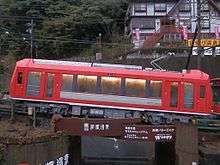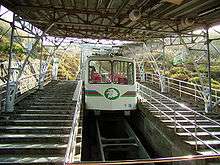Hakone Tozan Line
| Hakone Tozan Line | |
|---|---|
|
| |
|
Hakone Tozan Railway 1000 series trainset "Bernina" at Gōra Station | |
| Overview | |
| Native name | 箱根登山鉄道線 |
| Locale | Kanagawa Prefecture, Japan |
| Stations | 11 |
| Operation | |
| Owner | Odakyu Group |
| Operator(s) | Hakone Tozan Railway |
| Depot(s) | Iriuda |
| Technical | |
| Line length | 15.0 km (9.3 mi) |
| Number of tracks | 1 |
| Track gauge | 1,435 mm (4 ft 8 1⁄2 in) standard gauge |
| Highest elevation | 553 m (1,814 ft) |

The Hakone Tozan Line (箱根登山鉄道線 Hakone Tozan Tetsudō-sen, lit. Hakone Mountain-Climbing Railroad Line) is a mountain railway in Japan operated by the Hakone Tozan Railway. This company belongs to the Odakyu Group, and also owns the Hakone Tozan Cable Car.
The section of the line from Odawara Station to Hakone-Yumoto Station started operations in 1919, with current terminus Gōra reached in 1930. Since 2006, only Odakyū Odawara Line trains run on the previously dual-gauge section from Odawara Station to Hakone-Yumoto Station. From Gora, visitors can continue up the mountain on the Hakone Tozan Cable Car.
The railway is capable of climbing one meter vertically for every 12.5 meters of horizontal distance, a maximum gradient of 8%. The line traverses Fuji-Hakone-Izu National Park, so the line was carefully designed to limit the impact on scenery. Due to the difficult conditions, the line has three switchbacks used to ascend particularly steep sections.
Description

- Length: 15.0 km (9.3 mi)
- Gauge:
- Odawara - Iriuda: 1,067 mm (3 ft 6 in)
- Iriuda - Hakone-Yumoto: 1,067 mm (3 ft 6 in)/1,435 mm (4 ft 8 1⁄2 in) (dual gauge)
- Hakone-Yumoto - Gōra: 1,435 mm (4 ft 8 1⁄2 in)
- Stations: 11 (including termini)
- Track: single
- Power:
- Odawara - Hakone-Yumoto: 1,500 V DC overhead supply
- Hakone-Yumoto - Gōra: 750 V DC overhead supply
- Block system: Automatic (cab signal/digital) (CTC)
Stations
- Trains: "S" = All stop, "|" = All pass.
| No. | Stations/ Signal Stations |
Japanese | Distance (km) |
Elevation (m) |
Stops | Location (in Kanagawa) | |||
|---|---|---|---|---|---|---|---|---|---|
| Limited Express |
Local | Local | |||||||
| OH-47 | Odawara | 小田原 | 0.0 | 26 | S | S | Odawara | ||
| OH-48 | Hakone-Itabashi | 箱根板橋 | 1.7 | 1.7 | 27 | | | S | ||
| OH-49 | Kazamatsuri | 風祭 | 1.5 | 3.2 | 48 | | | S | ||
| OH-50 | Iriuda | 入生田 | 1.0 | 4.2 | 66 | | | S | (terminus) | |
| OH-51 | Hakone-Yumoto | 箱根湯本 | 1.9 | 6.1 | 108 | S | S | S | Hakone, Ashigarashimo District |
| OH-52 | Tōnosawa | 塔ノ沢 | 1.0 | 7.1 | 165 | (terminus, from/to Shinjuku (some from/to Kita-Senju)) |
(terminus, from/to Shin-Matsuda) |
S | |
| – | Deyama Switchback | 出山信号場 | 1.2 | 8.3 | 234 | No passengers | |||
| OH-53 | Ōhiradai | 大平台 | 1.6 | 9.9 | 349 | S | |||
| – | Kami-Ōhiradai Switchback | 上大平台信号場 | 0.5 | 10.4 | 359 | No passengers | |||
| – | Sennindai Signal Stop | 仙人台信号場 | 0.8 | 11.2 | 410 | No passengers | |||
| OH-54 | Miyanoshita | 宮ノ下 | 0.9 | 12.1 | 448 | S | |||
| OH-55 | Kowakidani | 小涌谷 | 1.3 | 13.4 | 535 | S | |||
| OH-56 | Chōkoku-no-Mori | 彫刻の森 | 0.9 | 14.3 | 551 | S | |||
| OH-57 | Gōra | 強羅 | 0.7 | 15.0 | 553 | S | |||
- Transfers:
- At Odawara Station:
- At Gōra Station:
- Hakone-Yumoto Station is the terminus for all Hakone Tozan Line trains.
- On the Odawara - Hakone-Yumoto section, Limited Express "Romancecar" and Local trains run through to and from the Odakyu Odawara Line.
- Odakyu LE, Super Hakone, Hakone and Homeway services run from/to Shinjuku Station.
- Odakyu LE Metro Hakone runs between Hakone-Yumoto and Kita-Senju Station, on Tokyo Metro Chiyoda Line at weekends only.
- Local trains runs between Odawara and Hakone-Yumoto, partly from/to Shin-Matsuda Station using 4-car Odakyu EMUs.
- Section between Hakone-Yumoto and Gōra is operated by local trains only, using Hakone Tozan 2/3-car EMUs.
- Trains stop at three signal stops which have no passenger platforms.
- There are three switchbacks: Deyama, Ōhiradai, and Kami-Ōhiradai.
- Journey time between Odawara - Hakone-Yumoto is approximately 15 minutes, Hakone-Yumoto - Gōra is approximately 40 minutes, Shinjuku - Hakone-Yumoto is approximately an hour and 25–35 minutes by limited express.
Signal stops
There are three signal stops on the Hakone Tozan Line in addition to the regular passenger stations. All of them have a siding track and two of them have switchbacks.
Deyama Switchback
Signal stop with a switchback. 234 m AMSL. 35°13′57″N 139°05′14″E / 35.232402°N 139.087167°E
Kami-Ōhiradai Switchback
Signal stop with a switchback near Ōhiradai station which also has a switchback. 359 m AMSL. 35°14′08″N 139°04′32″E / 35.235604°N 139.075444°E
Sennindai Signal Stop
Signal stop without a switchback. 410 m AMSL. 35°14′18″N 139°04′09″E / 35.238215°N 139.069042°E
 Deyama switchback
Deyama switchback Kami-Ōhiradai switchback
Kami-Ōhiradai switchback Sennindai signal stop
Sennindai signal stop
Rolling stock
Hakone Tozan Railway (Hakone-Yumoto - Gōra)
- MoHa 1
- MoHa 2
- 1000 series ("Bernina", named after the Rhätische Bahn Line in Switzerland)
- 2000 series ("St. Moritz")
- 3000 series (since November 2014)[1]
- 3100 series two-car EMU (since May 2017)[2]
- MoNi 1 (non-revenue car)
All trains are based at Iriuda Depot.
Former
- MoHa 3
- Yu 1 (as goods wagon)
Odakyu Electric Railway (Shinjuku - Odawara - Hakone-Yumoto)
Romancecar EMUs
Commuter EMUs
History
- October 1, 1888: Odawara Horse-drawn Railway opens from Kōzu Station via Odawara Station, to Hakone-Yumoto Station.
- October 31, 1896: Operating company name is changed to Odawara Electric Railway.
- March 21, 1900: Line is electrified (as a tram, 600 V DC).
- June 1, 1919: Line opens between Hakone-Yumoto and Gōra as an electrified (600 V DC) funicular railway.
- December 16, 1920: Tram line closes between Kōzu - Odawara, and connected with the JGR (now JR) Tōkaidō Main Line at Odawara.
- August 16, 1928: Hakone Tozan Railway is founded.
- October 1, 1935: Mainline railway is extended from Hakone-Yumoto to Odawara. Tram line remains between Odawara - Hakone-Itabashi, and is renamed the "Odawara Town Line".
- December 20, 1940: Tram section is renamed "Odawara City Line".
- June 1, 1948: Hakone Tozan Railway becomes part of the Odakyu Group.
- August 1, 1950: Odakyu Electric Railway begins operating Limited Express and Express trains from Shinjuku to Hakone-Yumoto. The line voltage is changed to 1,500 V DC for the dual gauge section between Odawara and Hakone-Yumoto.
- June 1, 1956: Odawara City Line (tram) is abandoned.
- July 14, 1993: Hakone-Yumoto - Gōra section is uprated from 600 to 750 V DC. Operations start using 3-car EMUs.
- March 18, 2006: Hakone Tozan Railway discontinues operation using its own units between Odawara and Hakone-Yumoto. Dual-gauge section reduced to Iriuda - Hakone-Yumoto.
- March 15, 2008: New Odakyu "Romancecar" through service starts from Kita-Senju Station.

Microsoft Train Simulator
This route appears in Microsoft Train Simulator complete with scenarios simulating prototypical operation (Only from Odawara to Hakone-Yumoto).
References
- ↑ 箱根登山鉄道3000形を導入 [Hakone Tozan Railway to introduce 3000 series]. Japan Railfan Magazine Online (in Japanese). Japan: Koyusha Co., Ltd. 6 June 2013. Archived from the original on 4 March 2016. Retrieved 6 December 2016.
- ↑ 箱根登山鉄道,3100形を導入 [Hakone Tozan Railway to introduce 3100 series]. Japan Railfan Magazine Online (in Japanese). Japan: Koyusha Co., Ltd. 6 December 2016. Archived from the original on 6 December 2016. Retrieved 6 December 2016.
External links
| Wikimedia Commons has media related to Hakone Tozan Railway. |
- Hakone Tozan Railway Official Site
- Hakone Navi (Odakyu official sightseeing guide, in English)
